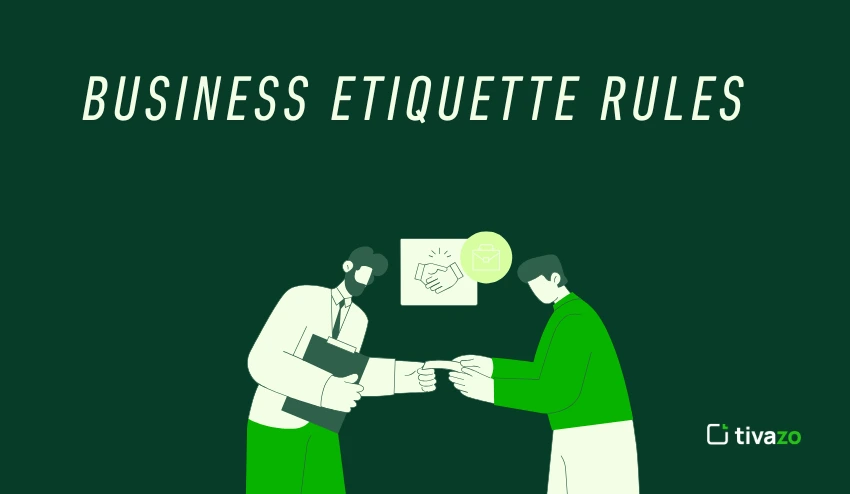Welcome to the ultimate guide to business etiquette, your roadmap for understanding professionalism and developing credibility. If you are here to learn, want to create best practices to share with your team, or you just need to find a trusted source for business etiquette content, you are in the right place!
What is Business Etiquette? What does that mean?
Business etiquette is generally thought of as the combination of professional manners, behaviors, and unstated rules governing respectful and polished interactions in work settings. Business etiquette ensures that professionals are polite, clear, and culturally sensitive, and professional every time they have an interaction at work. It is the first step toward establishing trust and effectively presenting competence in professional settings.
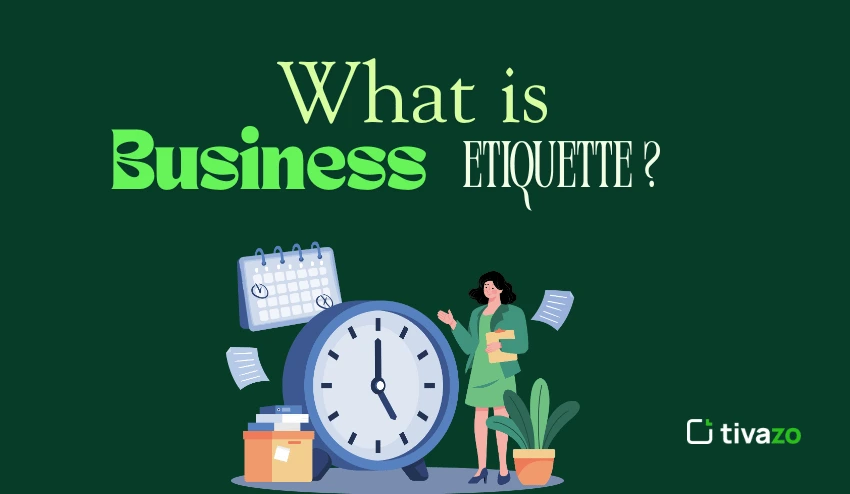
Key features of business etiquette include:
- First Impressions: The way you present yourself, from handshakes, clothing, and generally, how you present yourself, will affect how people perceive you.
- Communication Skills: Communicating in such a way that is clear, concise, and respectful establishes credibility with others.
- Time Respect: Being on time demonstrates that you can be trusted and implies professionalism.
- Workplace Courtesies: Small gestures such as saying hello to coworkers and saying thank you go a long way in creating a professional work culture.
- Flexibility: Understanding that there are cultural differences and adjusting one’s behavior to accommodate them demonstrates a level of global awareness.
- Professional Space: Understanding what is appropriate personal space, while respecting the personal privacy of colleagues, demonstrates an individual who can be trusted.
- Digital Etiquette: How emails are composed, tone in emails, body language in video and virtual meetings, and expressions in face-to-face meetings are all equally important.
What Are Some Examples of Good Business Etiquette?
These are actionable examples of business etiquette in action:
- Greetings with a firm handshake and eye contact
- Communicating concisely, politely, and clearly
- Listening attentively without interrupting
- Respecting personal and cultural boundaries
- Dressing according to your industry
- Following up with a thank-you note or email, within a day or so
- Being on time for meetings and deadlines.
These actions illustrate how business etiquette supports professionalism in everyday work. You can get some guidance from someone who identifies respect, clarity, punctuality, and appearance as key concepts!
The Basic Values of Business Etiquette
Let us take a deeper look at the basic tenets of business etiquette:
1. Respect for others
Be considerate of others—say please and thank you, listen effectively, and be on time. Respect is at the heart of every definition of business etiquette.
2. Communication
Utilize proper tone and format in oral and written communication. Accurate communication minimizes miscommunication and demonstrates professionalism.
3. Punctuality
Being on time is always about dependability, and dependability is at the core of business etiquette.
4. Appropriate appearance
Dress appropriately for your setting and be well-groomed—your appearance reflects professionalism before you utter a word.
5. Listening
Pay attention to speakers, ask for clarification, and avoid distractions: listening is often lost in the hustle, but it shows respect and engagement.
6. Variability, Cultural, and Adaptability
Change according to the cultural setting—different styles of communication, greetings, and approaches must fit the varied global business context.
7. Recognition and Thanks Declaring your Gratitude
Recognize others’ contributions, say thank you, and acknowledge lesser achievements. A business needs cultural goodwill, and goodwill is made through recognition and thanks.
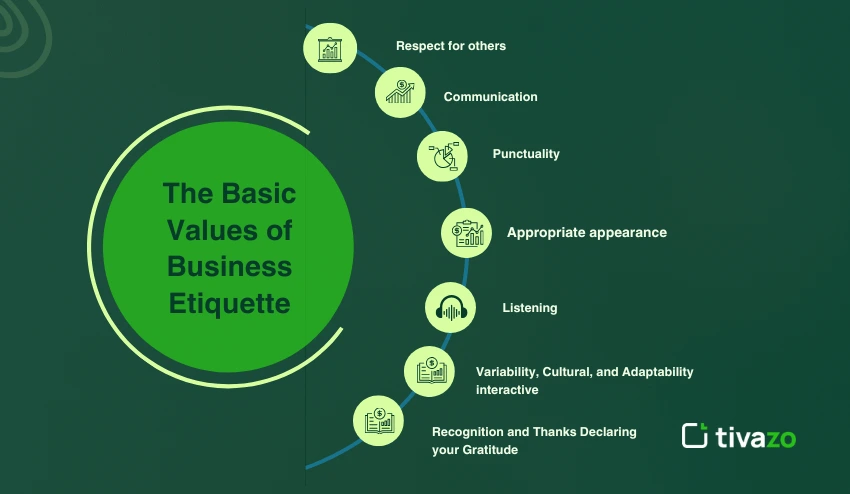
What Makes Business Etiquette So Important?
The importance of business etiquette affects many different areas:
1. Trust & Professional Relationships
As a result of the initial impressions and ongoing courtesy collisions, trust and cooperation ensue! In every relationship, people, whether they are colleagues, clients, or partners, are likely to work with someone who appreciates professional manners. The trust established through business etiquette lays the foundation for long-term relationships, loyalty, and ultimately success!
2. Communication Efficiency
Business etiquette will aid in cultivating polite, unambiguous interactions that help prevent friction and misunderstanding. Business etiquette assures that the essence of emails, meetings, and conversations is received as intended, allowing easy restoration and resolution in case of misunderstandings. Maintaining strong communication etiquette will mitigate communication issues, which will save time in the long run!
3. Enhanced Credibility
Etiquette fosters mutual respect, productivity, and morale. A workplace committed to business etiquette will cultivate a culture of ensuring team members feel valued, motivated, and willing to collaborate. Small strokes, such as warmly greeting others or acknowledging someone else’s accomplishments, can achieve a culture of support and camaraderie!
4. Global Business Attain Success
Cultural Awareness Will Prevent Mistakes in International Business Contexts. If professionals familiarize themselves with local customs, greetings, communication methods, etc., it will help them build stronger relationships globally while also avoiding humiliating or damaging errors.
5. Conflict Resolution
Business etiquette gives individuals a roadmap for how to respectfully resolve disagreements. By remaining polite and calm, individuals are able to take a constructive path towards resolving conflict while building a relationship.
6. Constructive Workplace Culture
Promotes mutual respect, productivity, and morale. A workplace that supports etiquette provides a forum in which team members will feel appreciated, motivated, and keen to collaborate. Simple gestures, such as greeting one another with warmth or commending each other’s achievements, help to foster a culture of assistance.
7. International Business
Cultural Intelligence Will Save International Business Professionals From Embarrassingly Stupid and Expensive Blunders. Professional voices and relationships are similar, better known as etiquette. If professionals are more versed in local customs, greetings, communications, local and national customs and procedures, then they can develop better relationships globally while avoiding embarrassment and/or costly errors.
In conclusion, business etiquette is more than just good manners; it has a direct link to trust, cooperation, promotion, and business success.
What are the 5 fundamentals of business etiquette?
Here is a quick table that summarizes the 5 principles:
| Basic | Descritpion |
| Respect | Consideration for others in their speech, actions, and time |
| Communication | Clearly, appropriately, and professionally |
| Punctuality | Timeliness in meetings and deadlines |
| Appearance | Well-groomed, industry-appropriate attire |
| Active Listening | Engaged and respectful attention to others. |
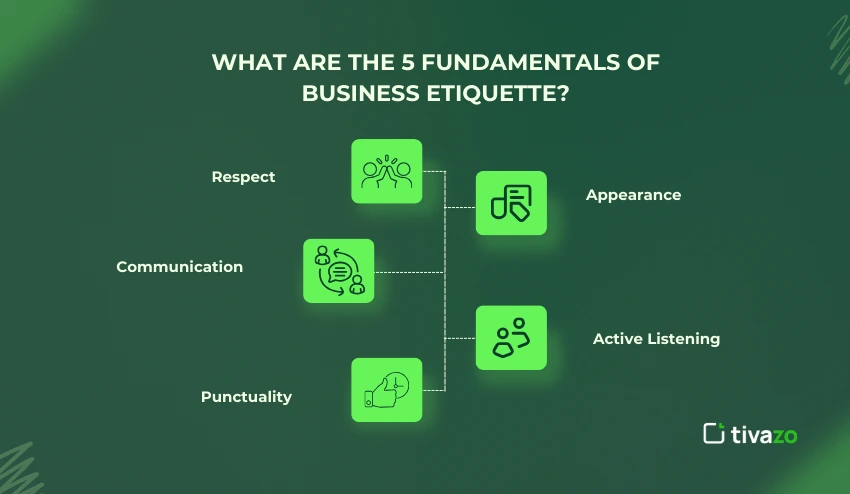
These five fundamentals of business etiquette are the foundation of every meaningful professional conversation.
Respect: Always practice consideration of other people’s time and viewpoints. Common courtesies such as holding doors, greeting co-workers, and acknowledging other people’s contributions will create a more respectful and positive environment.
1. Respect
Respect is at the heart of good business ethics. Respect is basically valuing other people’s time, opinions, and personal space. Simple things like listening without interrupting, being on time, and using polite expressions can make a difference. When we respect others, we develop trust with the bonus of quality professional relationships.
2. Communication
All communication, written and verbal, should be courteous, clear, and professional. When unnecessary, consider avoiding jargon; too much jargon can lead to people misunderstanding your points.
3. Punctuality
Showing up to meetings and appointments on time consistently demonstrates that you value other people’s time and trust. Showing up late might lessen the opinions that others hold of you in both professional and personal situations, too. Everyone has that one person we all know who is consistently late, and how that impacts our relationship with them.
4. Appearance
Dressing appropriately for your workplace is sometimes the first signal you can communicate about your professionalism. The highest form of respect for others and yourself is personal hygiene, along with clothing choices. If you cannot even pay attention to your clothing, it raises questions about whether you can pay attention to detail in your work.
5. Active listening
Engaging with speakers, whether in face-to-face or virtual environments, means paying attention to and interacting with the speaker, including clarifying questions. Remembering that you need to remain engaged respectfully and don’t have to be a distraction to the speaker or other participants is also part of active listening.
Understanding what you previously learned about these fundamentals, we can now share how to expertly implement them so that your business etiquette is intact and visible across your professional experience, utilizing them consistently to build trust, credibility, and workplace relationships that are likely to last a lifetime.
Rule of 12 Etiquette
The rule of 12 etiquette is a simple, represented principle to enhance that prominent first impression:
- Visual Assessment from 12 Feet: Imagine yourself entering a room and being observed from 12 feet away. Before you said anything, you were being assessed, and your appearance, posture, body language, and presence matter.
- The top 12 inches: Focus on the top 12 inches of your body – your face, expression, and posture. A confident smile, standing up straight, and having open gestures will create a strong, meaningful first impression.
- The first 12 words: Let the first 12 words of your greeting or introduction be memorable, delivered clearly, with warmth and confidence. First impressions count, and you need to engage quickly.
The rule of 12 etiquette also calls attention to many smaller details: being clean, grooming your hair, and showing confident eye contact. These subtle clues are remembered beyond the material of your initial conversation.
This rule will be an adequate strategy when you network, interview, and engage in meetings for your profession. If you practice this rule, you will enjoy great success in your business etiquette, and it will last long in your network’s memory.
What Are the 3 R’s of Business Etiquette?
The “3 R’s of business etiquette” often refer to:
- Respect – respecting the time, space, and ideas of others
- Responsibility – taking ownership of your words and actions as a professional
- Reliability – consistently meeting commitments and being honest
Together, these reinforce the fundamental values of business etiquette and help people build credibility and professionalism.
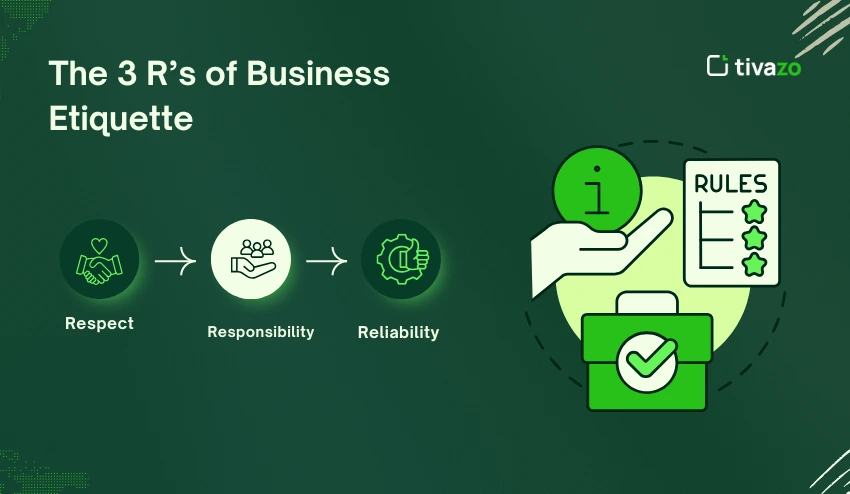
Conclusion
It is essential to practice business etiquette in order to be successful. Business etiquette encompasses everything from the fundamental principles of etiquette—respect, effective communication, punctuality, appearance, and active listening—to the behavioral rules or guidelines for etiquette, like the Rule of 12 and 3 R’s (Respect, Responsibility, and Reliability). Etiquette will govern how you are perceived and valued by colleagues, clients, and partners as you put these principles into practice.
Practicing proper business etiquette gives you a level of trust, builds better relationships, enhances communication, generates a positive workplace culture, and supports your personal reputation and potential for career advancement, as well as success in business globally. When you practice these actions consistently, you put yourself in a position to present yourself as a professional, confident, and ultimately credible at every turn.
When you are entering a meeting space, writing an email, or networking, practicing business etiquette will always allow you to make a great, positive impression and establish belief in your potential to achieve your professional goal.
